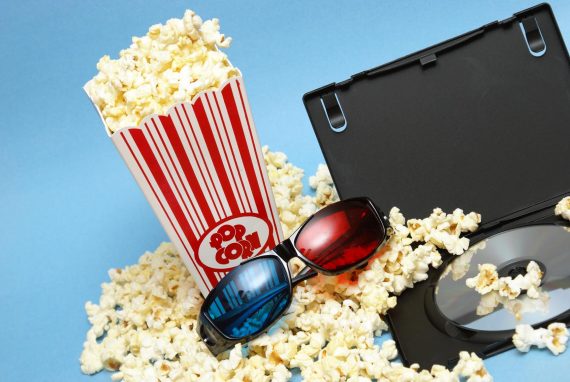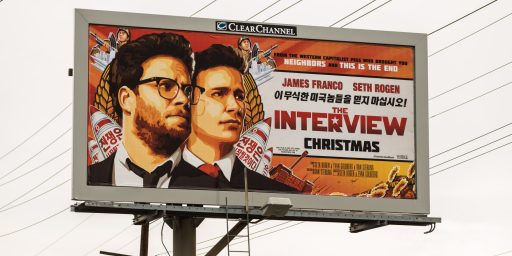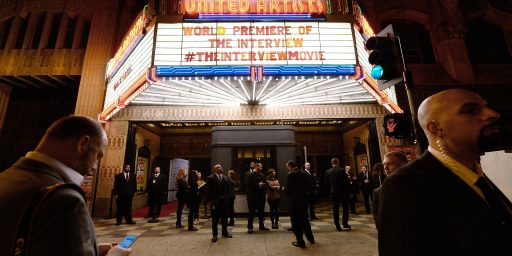Movie Theater Chains Closing Over Coronavirus
A sign of the times.

Some localities have ordered theaters closed due to the COVID-19 pandemic. Now, AMC, Regal, and other national chains have announced that they’re closing nationwide.
AMC Theaters, the largest theater chain in the United States, will shut its doors nationwide for between six to 12 weeks.
The move complies with local, state, and federal directives to help fight the spread of COVID-19, the disease caused by the novel coronavirus.
Over the last few days, multiple states and cities have declared that venues like movie theaters, bars, and restaurants must close. The federal government also recommended that public gatherings shouldn’t exceed 10 people, making it impossible for movie theaters to operate.
“We are ever so disappointed for our moviegoing guests and for our employee teams that the new CDC guidelines that Americans should not gather in groups larger than 10 people make it impossible to open our theaters,” CEO Adam Aron said in a press release. “We will continue to monitor this situation very closely and look forward to the day we can again delight moviegoers nationwide by reopening AMC movie theaters in accordance with guidance from the CDC and local health authorities.”
AMC isn’t the only chain shutting down its operations for several weeks as the company grapples with the pandemic. Regal, another popular theater chain in the US, is also closing its doors. Independent theaters like Alamo Drafthouse and Nitehawk Cinemas in New York City have also decided to close. Prior to the closures, the box office saw its worst weekend in the last 20 years, hitting an unprecedented low, seeing a total of $55.3 million between March 13th and March 15th. Even before AMC and Regal made the choice for audiences, people weren’t going to theaters. Movies like Onward, Disney Pixar’s newest joint, would usually gross more than $100 million domestically over a few weeks. The movie has only grossed $60 million domestically and an additional $40 million internationally.
A sign of the times, I guess.
Going to the theater is something of an antiquated experience given how many of us have large screen televisions, surround sound systems, and thousands of movies at our fingertips for streaming whenever we feel like it. But we’re wired to “get out of the house” and some films, notably those in action genres, are better with a massive screen and, sometimes, a large audience having a shared reaction.
Obviously, that’s the opposite of what we want during a pandemic.





We’re in for a rough ride. I keep thinking that what we need to do is just slow this thing down so hospitals don’t get overwhelmed and we can keep the supplies to them going. I’ve seen multiple reports that PPE(Personal Protective Equipment) are really under pressure, for instance. Beds and ventilators are another scarce resource. We can make more, but it takes time.
I suspect a lot won’t ever re-open.
Those are pretty much the only movies I bother seeing in theaters any more. Still, a few years back I went to see “Murder on the Orient Express,” and I was surprised at the grand scale used in the movie’s cinematography, especially as regards wide shots of scenery as the train makes its way across snowy mountains. I saw it again recently on TV, and those same scenes look ordinary.
A movie I wish I could see on a big screen is Citizen Kane. You really cannot appreciate the cinematography work on video, no matter how high def and how big your LED screen is. To give you an idea, Orson Welles put the name of the cinematographer, Gregg Toland, right beside his own as director in the opening credits. Long tradition in Hollywood is to give the director a whole screen for their name (it’s also the last of the opening credits).
For a good notion at what one misses, I recommend finding the DVD with commentary by Roger Ebert.
@Kathy: When my TV went out during the Great Recession, I bought a low-end 1080p Projector for around $300, and half a bolt of light-blocking cloth from Jo-Ann Fabrics for about $30. Grabbed some 2×4’s from the garage, and 30 minutes later (and a youtube video on how to stretch canvass on a frame), I had a really quite decent home theater set up.
And yeah, the viewing difference can be pretty amazing, and not just for classics like Citizen Kane or Lawrence of Arabia–my nieces and nephews were blown away by Jurassic Park, even though they had seen it a few times before.
If the proposed $1,000 a month thing becomes a reality,j I will do my part to stimulate the economy by upgrading to a 4k projector.
@Jay L Gischer:
VENTILATORS !!!
Key Takeaways:
( because these electro-mechanical devices are handling oxygen, as compared with room air, I’d think that you would want to be absolutely certain there are no electrical faults – part of the reason why strict safety regulations apply to the manufacture of these medical devices)
I can’t find the source, but I seem to recall that approx 10 days ago, HHS was saying that the emergency stockpile was about 40,000 units, and the healthcare professionals were estimating that another 100,000 units were likely to be needed.
@Bob@Youngstown: Alas, we’ve reached the point where there has been so much lying from this administration and its minions that even for a statement from HHS, I will now ask ‘are they saying this because it’s true or because it’s what Trump told them to say.’
ETA: Particularly when the difference in numbers is 8,900::40,000–a difference of 450%.
While Avengers: Endgame is not a cinematic masterpiece, I think I will remember seeing it the first time for the rest of my life, solely due to the crowd response to the climactic scene
@Bob@Youngstown:
Counterpoint:
Coronavirus: 3D printers save hospital with valves
@Stormy Dragon: I saw Endgame. Having not really followed the series, I’m afraid my reaction to the final battle scene was, “Who the hell are all these people?”
@Stormy Dragon:
That’s good news for valves, and I’ve no issue with the mass production of these valves or of patient conduits ( known as tubing) or of nasal cannulas and the like, but complete ventilators is a whole ‘nuther story. There are timers, pulsers, pressure regulators, electronic feedback circuits…. in short the device is complex and sophisticated. There are a thousand ways that it can go wrong and not do the job as intended. Many years ago, we used to use ambu bags, but that required a human to squeeze the bag at regular intervals with just the amount of pressure for hours . I doubt that we have the human resources to commit to that approach.
I’m trying to not be pessimistic, but the talk I’m hearing from Washington doesn’t appear to be candid.
@Just nutha ignint cracker:
Personally, I think that what your hearing from Washington (in general) is intended to avoid mass panic (regardless of the consequence to not being adequately warned/cautioned).
@Neil Hudelson:
Movies are supposed to be larger than life. It starts by having images literally larger than life.
Today’s theaters have great sound and decent images. But they lack the grandeur of the old theaters that sat hundreds of people (yes, even the IMAX theaters of today lack that). A few even had state-of-the-art sound systems. Remember “sensurround“?
Given the volume of movie productions today, though, large theaters would not be enough to show more than a fraction. That’s also why the multiplex went from 4 or 5 screens to dozens.
@Jay L Gischer:
If only someone had seen this coming, but from what I understand even a month ago no one thought of it. No one.
/snark…
@Michael Reynolds:
I suspect a lot won’t ever re-open.
Yup…it’ll be the end of that.
Too many show films to a room full of 5 people.
Sure, they have big opening weekends…but no steady demand.
I never liked theaters, even before 90% of everything was available at home. But in a world where I can stop, start, rewind, turn up or down, and do it all from my couch with a cocktail in hand, I think they’re past their sell-by date. And the move they’re making to reserved seats just puts the rancid cherry on top.
I feel a little bad for Onward. It’s a solid Pixar film, and being a new property, it’s a risk. The fact that it’s doing badly through no fault of its own is a little sad.
@David S.: Pixar has a golden reputation and the marketing power of Disney behind it. If Onward is any good at all, it will be treasured for generations.
@Stormy Dragon:
This wouldn’t occur in the US due to concerns about a liability lawsuit. Even in a pandemic.
@Daryl and his brother Darryl:
You know, it’s a well-known fact theaters make very little money from ticket sales. Most of that goes to the distributor, who then sends it to the studios. Theaters make money at the concession stand.
So during this downturn, they could try to sell movie snacks to go, or deliver them at home. Microwave popcorn is nothing like movie theater popcorn.
@Bob@Youngstown: I see the UK is asking Rolls Royce and other companies to make ventilators. They’re talking about two or three years to certify a new design with new software, but they’re also talking building existing designs or some sort of defeatured basic design. Of course building anything more complicated than a bucket requires a supply chain, and they aren’t working well these days.
Simply making an existing design seems the way to go, but this all may be Boris blowing.
@Neil Hudelson: Those projectors really do a nice job, if you can darken the room or just use it at night. I borrowed one from a teacher during Christmas break.
We projected it on a just a plain wall, no screen. It showed very clear.
Our local theater is limiting attendance to fifty, and they spread the people out. Only on some weekends do they get more than fifty people, depending on the movie. So it want be such a big deal if they have multiple showings.
The big problem is the price of popcorn and a drink. Now that is what gets you.
Apparently this is the report(Twitter thread w/link to source) that’s freaking out government leaders across the country. I hope it’s wrong.
@Sleeping Dog:
The 3D-Printer is getting sued by the original manufacturer (who charges $11k for the same valve).
@Katharsis: Thank you for the link. I’ll try to read the Imperial College report tomorrow. But the tweet thread summary is very good information. But I see it as good news. If we do what we’re doing now, their “suppression” strategy we can keep it to a few thousand deaths and not overwhelm the hospitals. But we have to get more serious about it and we have to keep it up until we get a vaccine, maybe late next year. If the report is right is we can control this. But it requires good leadership. If we screw up, millions die.
At least the tweet thread is a must read.
@gVOR08: HA! that’s like saying this is good news because all we have to do is find a unicorn who is best friends with a leprechaun. We’re never going to do a nationwide properly-administered serious suppression strategy for month after month after month.
I work with a woman of Mexican descent whose family is originally from a north part of Texas that used to be Mexico. More than once in the last week, customers in my store have looked at her, guessed she was Asian, and immediately reached for the hand sanitizer. And I am not making that up.
These idiots aren’t going to do a properly-administered anything. Buckle up.
@Stormy Dragon:
The government should indemnify. Then invite the the original manufacturer to explain publicly how many people they think should die to protect their intellectual property.
Well that’s it, isn’t it? When has corporate greed ever been held to account? This goes back to the bank bailouts…individuals, particularly those at the bottom of the economic ladder, are often held to account (work requirements for food stamps and Medicaid, among other things) but corporations? From the banks that were bailed out, to the gun manufacturers that can’t be sued, from the pharmaceutical companies who made sure they didn’t have to negotiate with the government over drug prices and now to this naked display of pure greed, it’s all disgusting, and the irony is that a lot of people voted for Trump hoping he would fix this, but he has only made it worse, because in the end, he’s with the corporations, in the end, he’s one of the elites that his supporters claim to hate so much…and in the end, this pandemic is exposing him for the complete fraud that he is…I wonder if that will be enough to defeat him in November…
@gVOR08:
Not exactly. To do that, we would have to keep the suppression tactics going until a vaccine could be deployed. 18 months? More?
It’s simply not possible that this administration will maintain draconian suppression all summer, much less through the election.
They should never have closed all those drive-ins.
@gVOR08: Here is a counter opinion on their methodology. (Another Twitter thread + official review doc).
Contact tracing relies on testing. Unfortunately I’ve also heard depressing news with testing. There are three tests that can be used in this process and we are only working with one of them. First there is a surveillance test that is faster and more qualitative (yes/no). There is a diagnostic test that is for helping doctors prescribe treatment based on extent of the infection, which is slower (quantitative). And there is an antibody test which can help find people who have already had the virus but recovered, which helps with tracing the virus and tracking herd immunity. We are only doing the diagnostic testing for whatever reason.
@Teve: @DrDaveT: I did put in a qualifier, “ But it requires good leadership.” Governors and mayors have been scared into taking action. I’m encouraged that even such a dedicated twit as Boris Johnson was motivated to act. Even Moscow Mitch might figure out that swamped hospitals and tens of thousands of dead Kentucky constituents is bad politics and could take priority over appointing judges. Hell, even Rand Paul might decide public health overrides pointless grandstanding. Nah, forget that last.
But yes, Trump is a big problem. Especially as the Imperial College paper predicts things could look good by late summer, but only stay good if we continue to clamp down. Trump will be desperate to declare victory before the election.
@Stormy Dragon:
Just checking….which one do you consider the climatic scene? I know the one that got me (and still kinda gets me on rewatches), but I just wanted to calibrate.
@Katharsis: Thanks. The critique seems to mostly say the Imperial College paper is pessimistic. Until better simulation is done, you gotta run with the best approximation you got.
Yes, testing is the crux. At risk of a visit from the Secret Service, if those million test kits tomorrow Mike Dense keeps talking about don’t show up he should be strung up on a lamppost. Alongside Kushner if there’s any truth to the story he tried to tie up rights to the German test. My understanding is that surveillance testing is symptoms, history, and fever. So it requires organization, not technology development. And thermometers. The stuff I was looking for at Walgreens yesterday was next to the empty thermometer shelf.
There’s also a more mundane issue. We can’t maintain food and drug supplies and distribtion, much less hospitals, with people six feet apart. We need hundreds of millions of masks and gloves. And we need, like the Chinese and Japanese, to accept people wearing them as a matter of course.
Whatever it’s flaws, the Imperial College paper provides some basis for planning.
@An Interested Party:
This is what makes me crazy. First, Republican voters are more than a little fuzzy on the concept of “elite”. But whatever your definition of the elite you hate, what sense did it make to elect a New York City self proclaimed billionaire?
@gVOR08: Good point. The biggest problem for people doing projections (particularly projections about bad things) is that their house is on the corner at the intersection of Damned if You Do and Damned if You Don’t. If things turn out better than they projected, they were overreacting. If not, the public asks ‘why weren’t you more realistic?’ The most worse case scenario is probably the safest starting point under those circumstances.
In other news, Cowlitz County, WA had it’s first corona virus isolation patient admitted on Sunday. This person lived in neighboring Lewis County–the regional hospital there apparently doesn’t have isolation/ICU–so our county’s infection rate stands at zero… for now. I urge my fellow residents to keep up the good work.